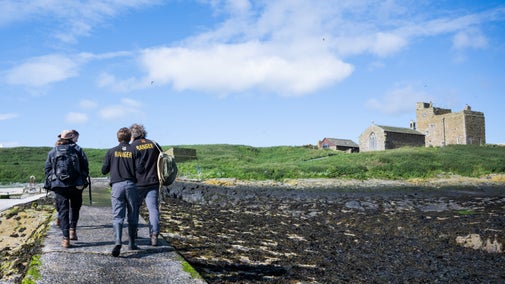
Discover more on the Farne Islands
Find out how to get to the Farne Islands, where to park, the things to see and do and more.

Each year in summer, thousands of Arctic terns come to the Farne Islands – and Inner Farne in particular – to nest and breed. Discover more about Arctic terns, including where they like to nest and how best to look after your head around these protective birds.
Arctic terns migrate to the northern hemisphere for the summer months and it’s here that they breed. When it comes to building a nest they favour bare sand and patches of path beside vegetation where the chicks can shelter and hide.
By the beginning of June most of the terns are sitting on their eggs. After a few weeks the newest generation has hatched and the adult terns will raise them until they’re ready to fly the nest.
Arctic terns will staunchly defend their eggs and chicks from perceived attack. This usually involves the bird clicking, flying up, making lots of noise and occasionally pecking the heads of passers-by.
This species famously undertakes the longest migration of any bird. Always chasing summer, the Arctic tern experiences more daylight hours than any other animal on the planet.
Once the chicks are ready to fly, the birds begin to make their way south again. By the end of the year, the terns will be somewhere in the southern hemisphere, most likely off the coast of Australia or the Antarctic pack ice.

This seabird is without doubt the species with the greatest presence on the Farne Islands. During the breeding season the Islands become the Arctic terns’ home and life very much revolves around them.
Because they nest on the ground, we ask that you walk steadily through the colony, paying close attention to where you step – there can be eggs and chicks on the paths from May to July on Inner Farne.
And because the terns are so protective of their young, we advise that you always wear a hat (though not a hard hat or cycle helmet) to protect your head from a swooping parent if you get too close to a chick.

By visiting the Farne Islands you are directly supporting the conservation work we do throughout the year. With your help, we can continue to ensure safe nesting sites and carry out work such as ringing the birds to better understand their migratory patterns.

Find out how to get to the Farne Islands, where to park, the things to see and do and more.
Find out what you might see when you take a boat trip to the Farne Islands, from wildlife such as puffins and grey seals, to centuries-old buildings including St Cuthbert's Chapel.

We’ve put together some guidelines for you to follow to make sure the wildlife stays safe when you visit, plus tips for taking photos without disturbing the seabirds.

Learn about the grey seal colony on the Farnes, as well as other seals that call the Islands home.

To sail around the Farne Islands, or land on Inner Farne you need to catch a boat from Seahouses harbour. It's recommended that you book your boat trip in advance. Read on to find out how to book and what to expect from your trip, and things to think about as you plan your visit.

Every year, thousands of puffins come to the places in our care to breed. Discover more about what they eat, when they breed and the best time to see them.

Find out more about how we care for Farne Islands in Northumberland, from repairing the boardwalks to surveying seals and ringing birds to track their movements.
